Ancient to Recent-Past Runoff Harvesting Agriculture in Recharge Playas of the Hyper-Arid Southern Israel
Abstract
:1. Introduction
2. Materials and Methods
2.1. Regional Settings
2.2. Obtaining Meteorological Data
2.3. Delineation of Drainage Basins and Playa Beds
2.4. Assessing the Playas’ Hydrological Conditions and Agronomic Potential
3. Results and Discussion
3.1. The Features of Recharge Playas
3.2. Indicators of Ancient to Recent-Past Runoff Agriculture
3.3. Evaluating Meteorological Conditions and Agronomic Potential
3.4. Data Integration and Implications
4. Conclusions
Acknowledgments
Author Contributions
Conflicts of Interest
References
- Rosen, M.R. The importance of groundwater in playas: A review of playa classifications and the sedimentology and hydrology of playas. In Paleoclimate and Basin Evolution of Playa Systems; Rosen, M.R., Ed.; Geological Society of America: Boulder, CO, USA, 1994. [Google Scholar]
- Goudie, A.S. Pans. Prog. Phys. Geogr. 1991, 15, 221–237. [Google Scholar] [CrossRef]
- Shaw, P.A.; Bryant, R.G. Pans, playas and salt lakes. In Arid Zone Geomorphology: Processes, Form and Change in Drylands; Thomas, D.S.G., Ed.; John Wiley & Sons: Chichester, UK, 2010. [Google Scholar]
- Goudie, A.S.; Wells, G.L. The nature, distribution and formation of pans in arid zones. Earth-Sci. Rev. 1995, 38, 1–69. [Google Scholar] [CrossRef]
- Gurdak, J.J.; Roe, C.D. Recharge Rates and Chemistry beneath Playas of the High Plains Aquifer—A Literature Review and Synthesis; US Geological Survey: Reston, VA, USA, 2009.
- Gillette, D.A.; Niemeyer, T.C.; Helm, P.J. Supply-limited horizontal sand drift at an ephemerally crusted, unvegetated saline playa. J. Geophys. Res. 2001, 106, 18085–18098. [Google Scholar] [CrossRef]
- Rodríguez-Rodríguez, M. Hydrogeology of ponds, pools, and playa-lakes of southern Spain. Wetlands 2007, 27, 819–830. [Google Scholar] [CrossRef]
- Briere, P.R. Playa, playa lake, sabkha: Proposed definitions for old terms. J. Arid Environ. 2000, 45, 1–7. [Google Scholar] [CrossRef]
- Nicoll, K. Geoarchaeological perspectives on Holocene climate change as a civilizing factor in the Egyptian Sahara. In Climates, Landscapes, and Civilizations; Giosan, L., Fuller, D.Q., Nicoll, K., Flad, R.K., Clift, P.D., Eds.; Wiley: Hoboken, NJ, USA, 2012; pp. 157–162. [Google Scholar]
- Nicoll, K. Nabta playa: Agriculture and domestication. In Encyclopedia of Global Archaeology; Springer: New York, NY, USA, 2014; pp. 5131–5134. [Google Scholar]
- Ron, M.; Shalmon, B.; Alon, D.; Ramon, U. Survey, Analysis, and Assessment of Natural Resources, Nature, and Human Heritage; DESHE: Tel Aviv, Israel, 2003. (In Hebrew) [Google Scholar]
- Rabinovich, R.; Ginat, H.; Schudack, M.; Schudack, U.; Ashckenazi-Polivoda, S.; Rogolsky, G. A late Cretaceous elasmosaurid of the Tethys Sea margins (southern Negev, Israel), and its palaeogeographic reconstruction. Neth. J. Geosci. 2015, 94, 73–86. [Google Scholar]
- Burg, A.; Zilberbrand, M.; Yechieli, Y. Radiocarbon variability in groundwater in an extremely arid zone—The Arava Valley, Israel. Radiocarbon 2013, 55, 963–978. [Google Scholar] [CrossRef]
- Israel Meteorological Service Website. Available online: http://www.ims.gov.il/ims/all_tahazit/ (accessed on 25 September 2017).
- GRASS GIS. Grass Development Team, Geographic Resources Analysis Support System Software. Open Source Geospatial Foundation Project. 2012. Available online: http://grass.osgeo.org (accessed on 25 September 2017).
- ASTER GDEM. Maintained by the NASA Land Processes Distributed Active Archive Center (LP DAAC). Available online: https://lpdaac.usgs.gov (accessed on 25 September 2017).
- Stavi, I.; Shem-Tov, R.; Ragolsky, G.; Lekach, J. Ancient runoff harvesting agriculture in the hyper-arid Uvda Valley of Israel: An agro-hydrological assessment. Land Degrad. Dev. 2017, 28, 2155–2165. [Google Scholar] [CrossRef]
- Allen, R.G.; Pereira, L.S.; Raes, D.; Smith, M. FAO Irrigation and Drainage Paper No. 56; Food and Agriculture Organization of the United Nations: Rome, Italy, 1990; Available online: http://www.kimberly.uidaho.edu/water/fao56/fao56.pdf (accessed on 25 September 2017).
- Eldridge, D.J.; Zaady, E.; Shachak, M. Infiltration through three contrasting biological soil crusts in patterned landscapes in the Negev, Israel. Catena 2000, 40, 323–336. [Google Scholar] [CrossRef]
- Avner, U. Uvda—Site#135, Archaeological Survey, 2006. non-published report. (In Hebrew)
- Erickson-Gini, T. Nabataean agriculture: Myth and reality. J. Arid Environ. 2012, 86, 50–54. [Google Scholar] [CrossRef]
- Avni, G.; Porat, N.; Avni, Y. Byzantine-Early Islamic agricultural systems in the Negev Highlands: Stages of development as interpreted through OSL dating. J. Field Archaeol. 2013, 38, 332–346. [Google Scholar] [CrossRef]
- Ashkenazi, E.; Chen, Y.; Avni, Y.; Lavee, S. Fruit trees’ survival ability in an arid desert environment without irrigation in the Negev Highlands of southern Israel. Isr. J. Plant Sci. 2015, 62, 5–16. [Google Scholar] [CrossRef]
- Stavi, I.; Ragolsky, G.; Shem-Tov, R.; Shlomi, Y.; Ackermann, O.; Rueff, H.; Lekach, J. Ancient through mid-twentieth century runoff harvesting agriculture in the hyper-arid Arava Valley of Israel. Catena 2018, 162, 80–87. [Google Scholar]
- Ragolsky, G. Human Culture Sites in the Menuha Ridge; Dead Sea and Arava Science Center: Newe Zohar, Israel, 2016. (In Hebrew) [Google Scholar]
- Avner, U. Settlement, agriculture and paleoclimate in Uvda Valley, southern Negev desert, 6th–3rd Millennia BC. In Water, Environment and Society in Times of Climatic Change; Issar, A.S., Brown, N., Eds.; Kluwer Academic Publishers: Dordrecht, The Netherlands, 1998; pp. 147–202. [Google Scholar]
- Avner, U. Uvda Archaeological Survey, 1981. non-published report. (In Hebrew)
- El-Aref, A. Beer Sheva and Its Tribes—The Bedouin Tribes in Beer Sheva County, 5th ed.; Ariel Publishing: Jerusalem, Israel, 1937. (In Hebrew) [Google Scholar]
- Breslavi, J. Aqaba, 2nd ed.; Israel Marine Center Publishing House: Haifa, Israel, 1948. (In Hebrew) [Google Scholar]
- Eggenberger, W.; Lemessa, D. Belg Rains Are Late: North Central Ethiopia Once Again Faces Difficult Year; Report of a Field Mission to Welo; University of Pennsylvania—African Studies Center: Addis Ababa, Ethiopia, 2000; Available online: http://www.africa.upenn.edu/Hornet/welo1804.html (accessed on 25 September 2017).
- Stomph, T.J.; De Ridder, N.; Steenhuis, T.S.; Van de Giesen, N.C. Scale effects of Hortonian overland flow and rainfall-runoff dynamics: Laboratory validation of a process-based model. Earth Surf. Process. Landf. 2012, 27, 847–855. [Google Scholar] [CrossRef]
- Soil Erosion Research Station (SERS). Spatial Statistical Model for Assessing Annual Runoff Quantities in Drainage Basins in the Southern Negev and Arava; Soil Erosion Research Station: Rishon LeẔiyyon, Israel, 1996. (In Hebrew) [Google Scholar]
- Steduto, P.; Hsiao, T.C.; Fereres, E.; Raes, D. Crop Yield Response to Water. FAO Irrigation and Drainage Paper No. 66; Food and Agriculture Organization of the United Nations: Rome, Italy, 2012; Available online: http://www.fao.org/docrep/016/i2800e/i2800e.pdf (accessed on 25 September 2017).
- Tubi, A.; Dayan, U. Tropical Plumes over the Middle East: Climatology and synoptic conditions. Atmos. Res. 2014, 145–146, 168–181. [Google Scholar] [CrossRef]
- Black, E.; Brayshaw, D.J.; Rambeau, C.M.C. Past, present and future precipitation in the Middle East: Insights from models and observations. Philos. Trans. R. Soc. Lond. A 2010, 368, 5173–5184. [Google Scholar] [CrossRef] [PubMed]
- Kaniewski, D.; Van Campo, E.; Weiss, H. Drought is a recurring challenge in the Middle East. Proc. Natl. Acad. Sci. USA 2012, 109, 3862–3867. [Google Scholar] [CrossRef] [PubMed]
- Ginat, H.; Shlomi, Y.; Batarseh, S.; Vogel, J. Reduction in precipitation levels in the Arava Valley (southern Israel and Jordan), 1949–2009. J. Dead-Sea Arava Res. 2011, 1, 1–7. [Google Scholar]
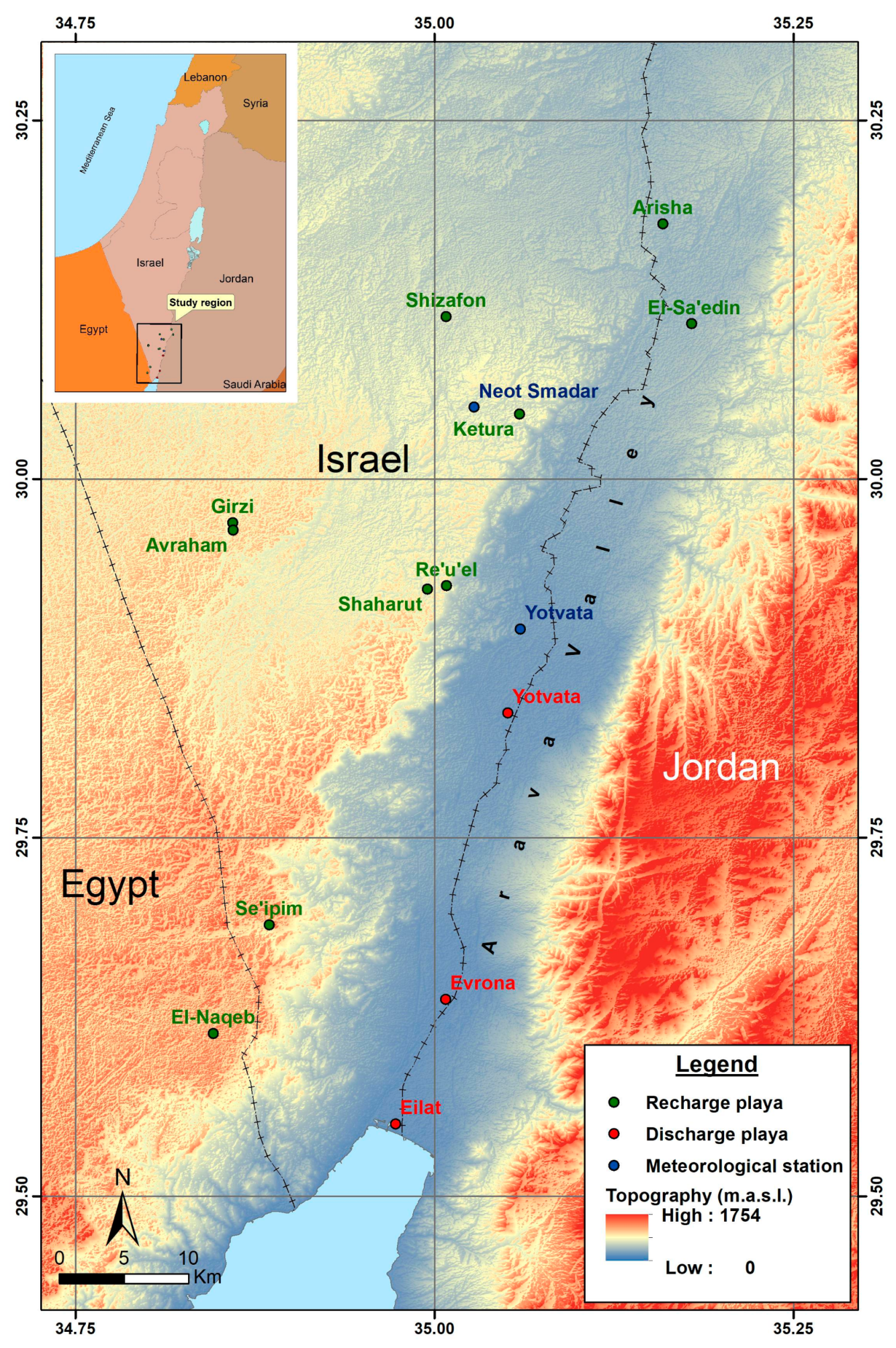
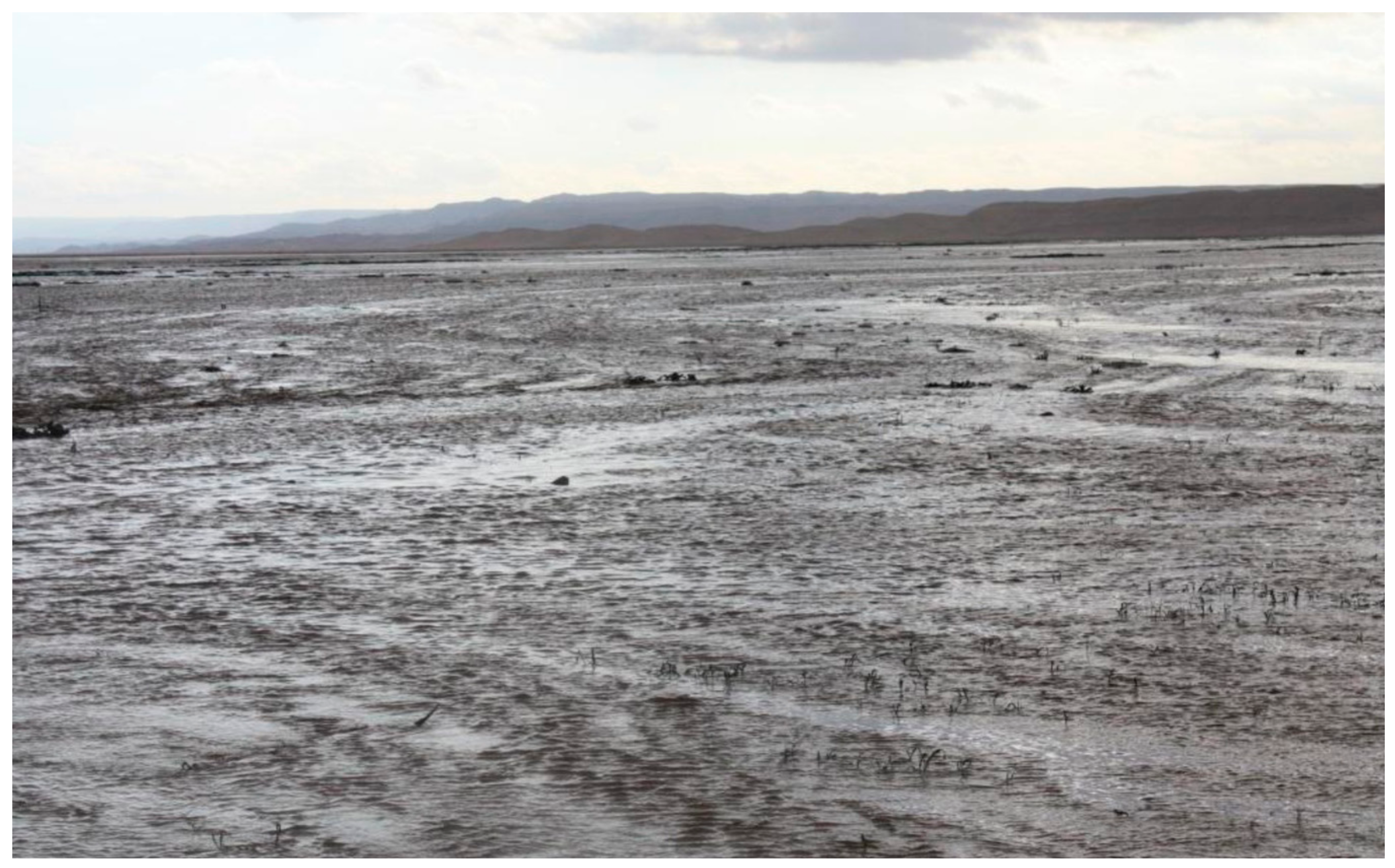
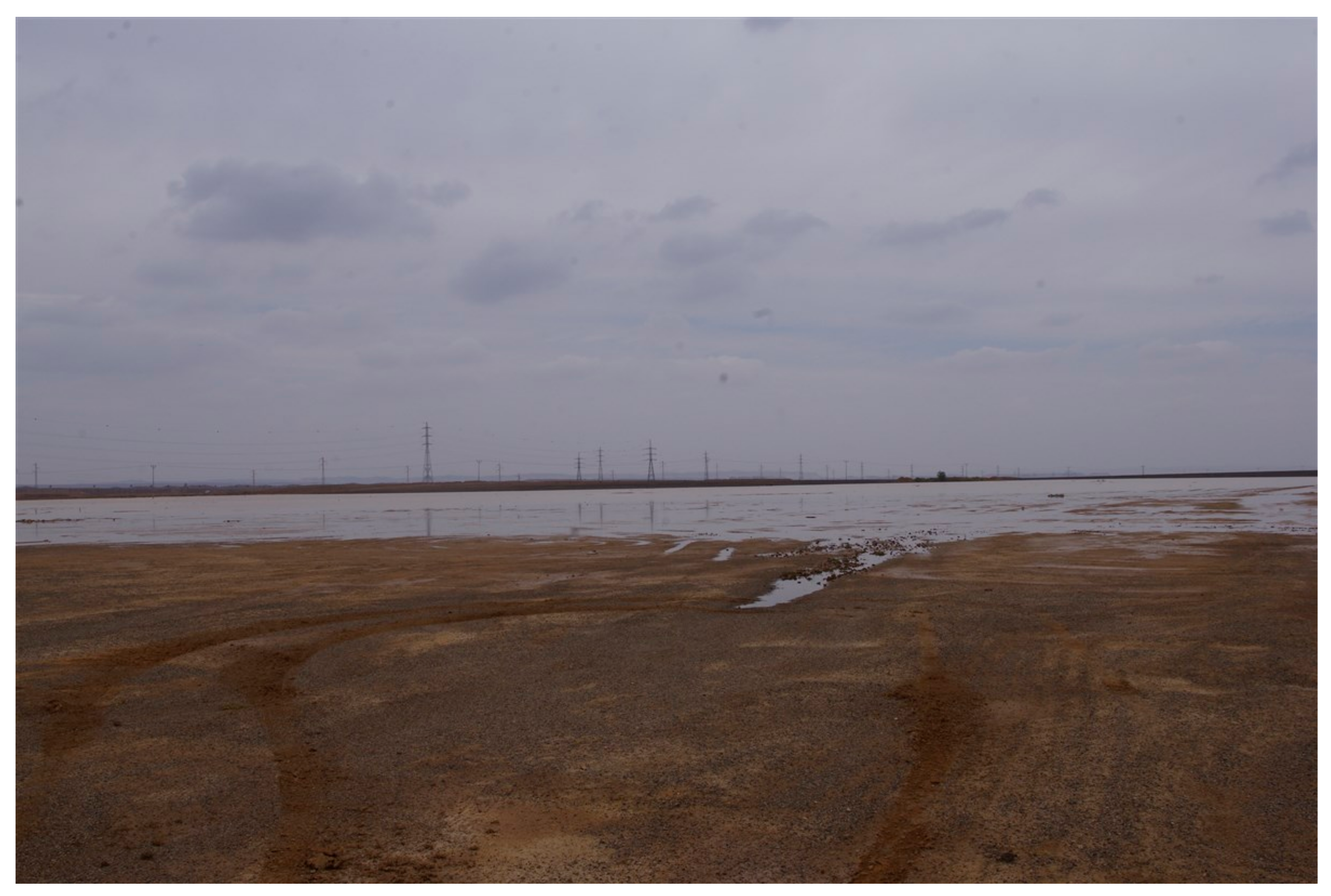
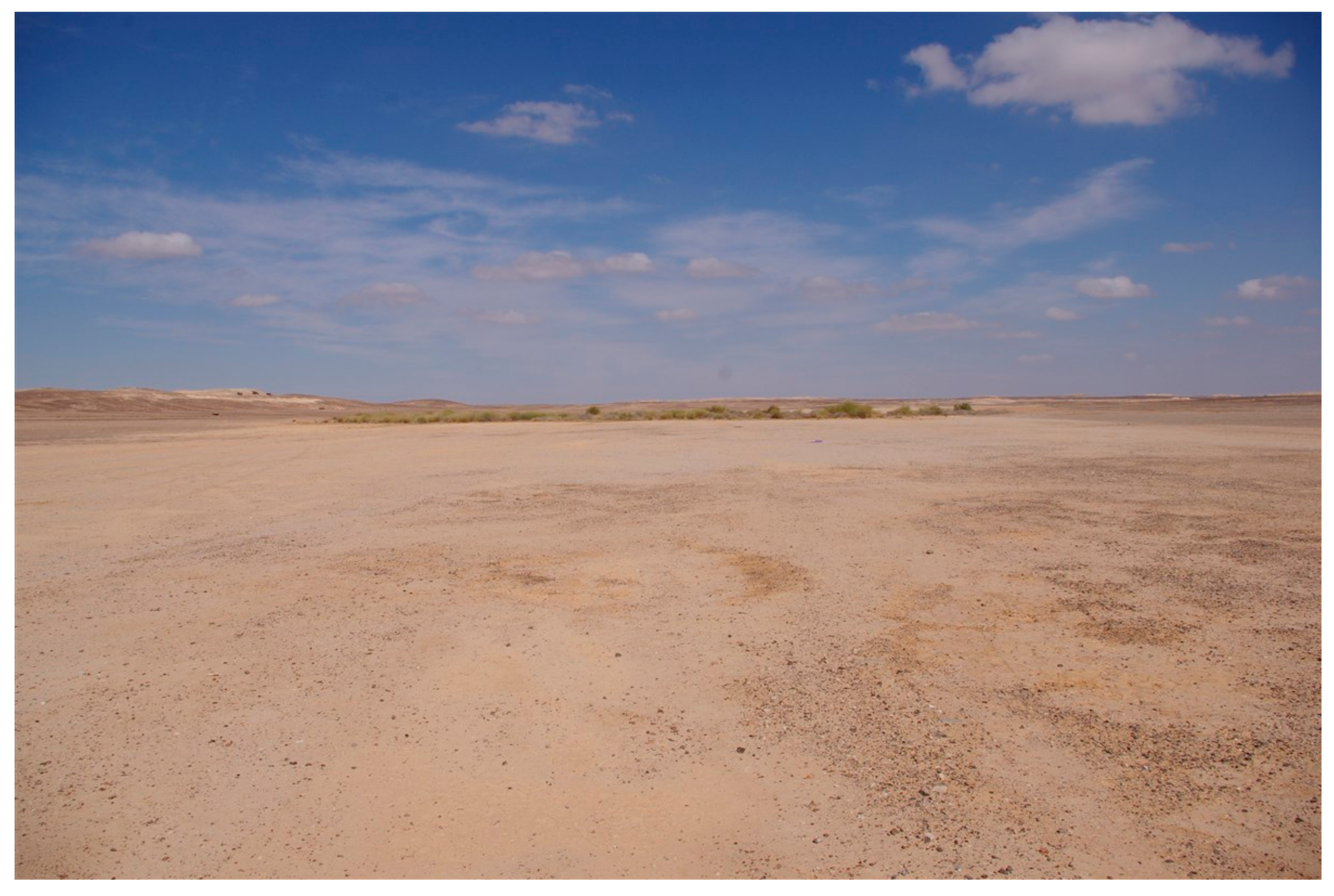
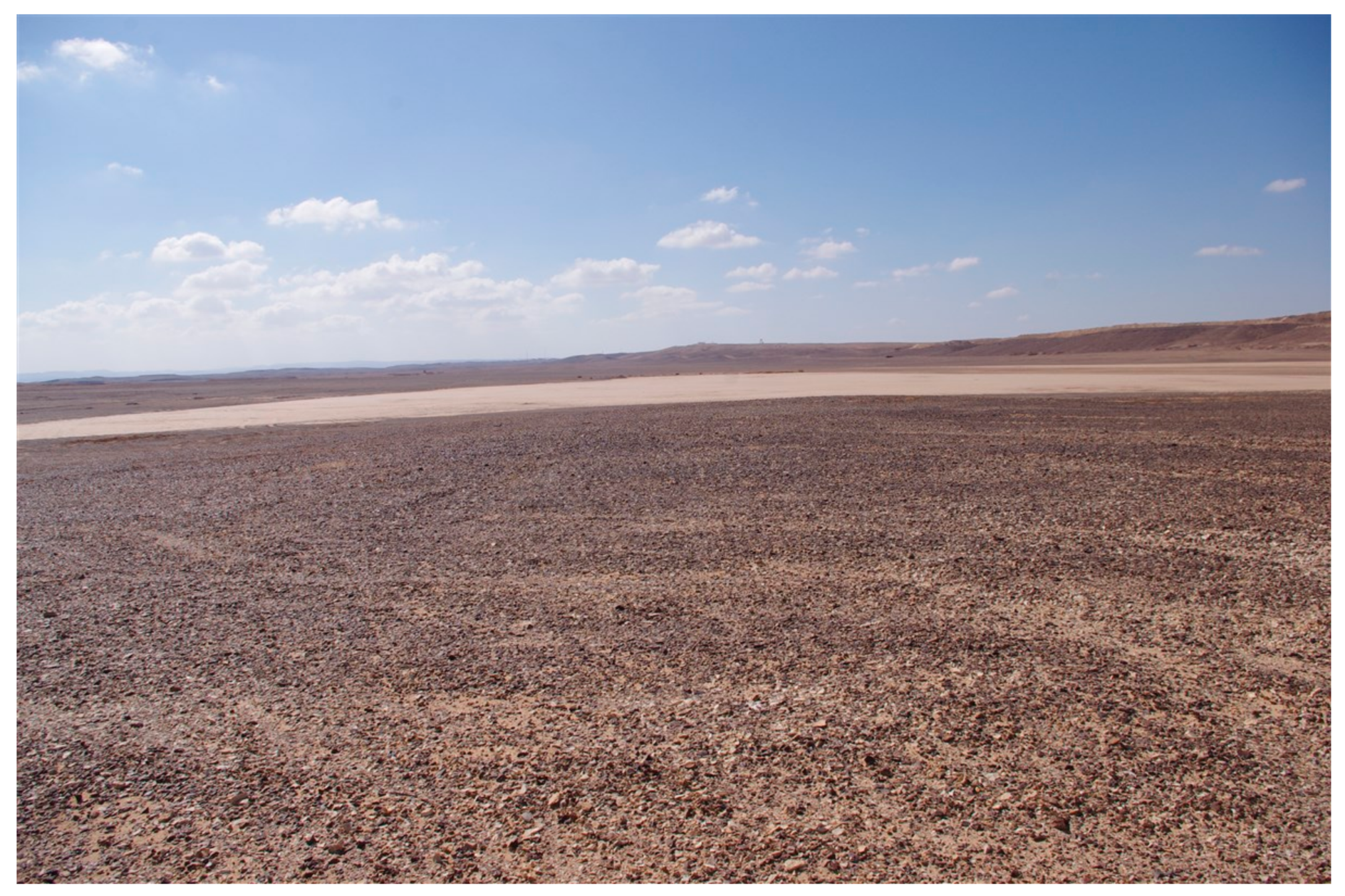
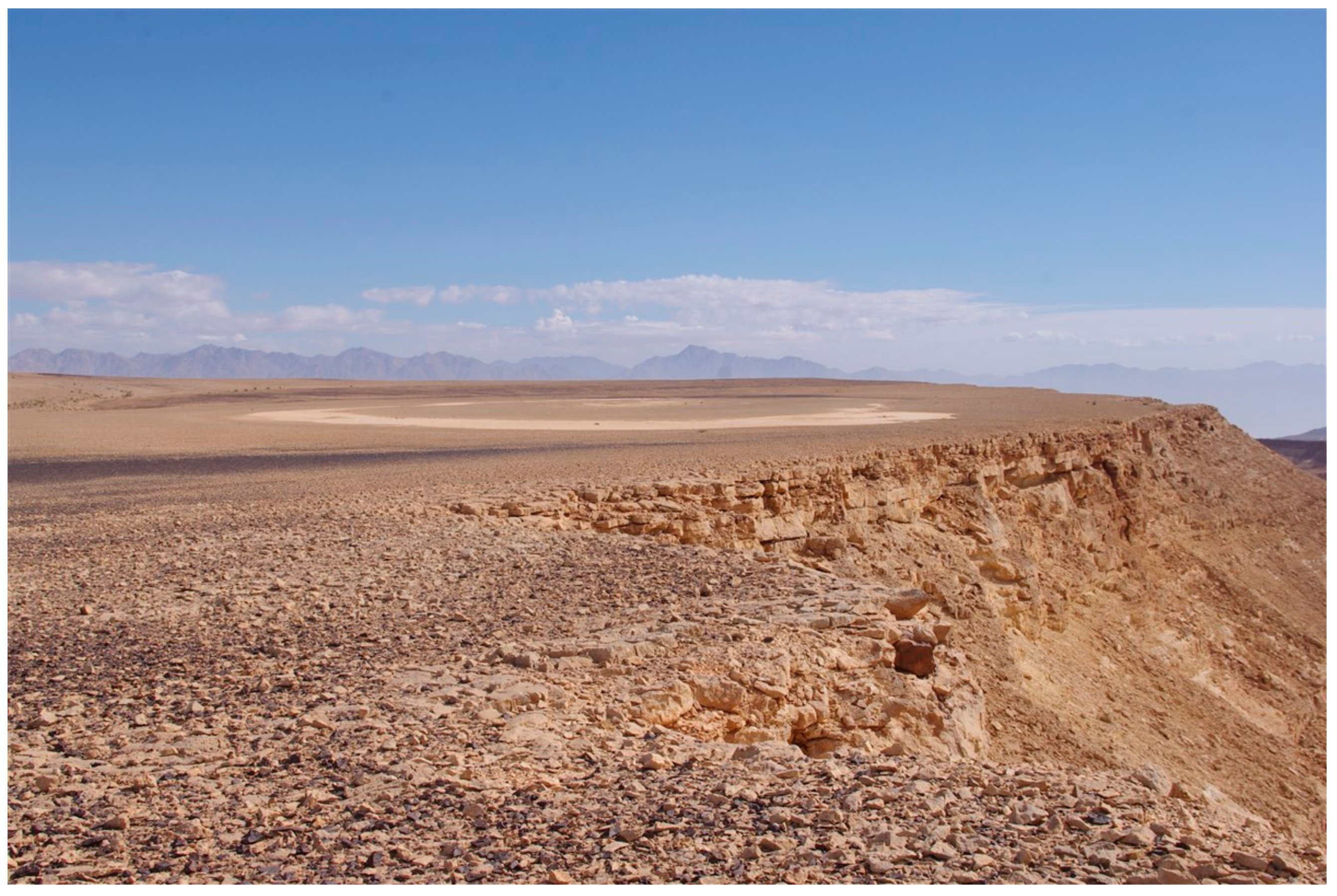
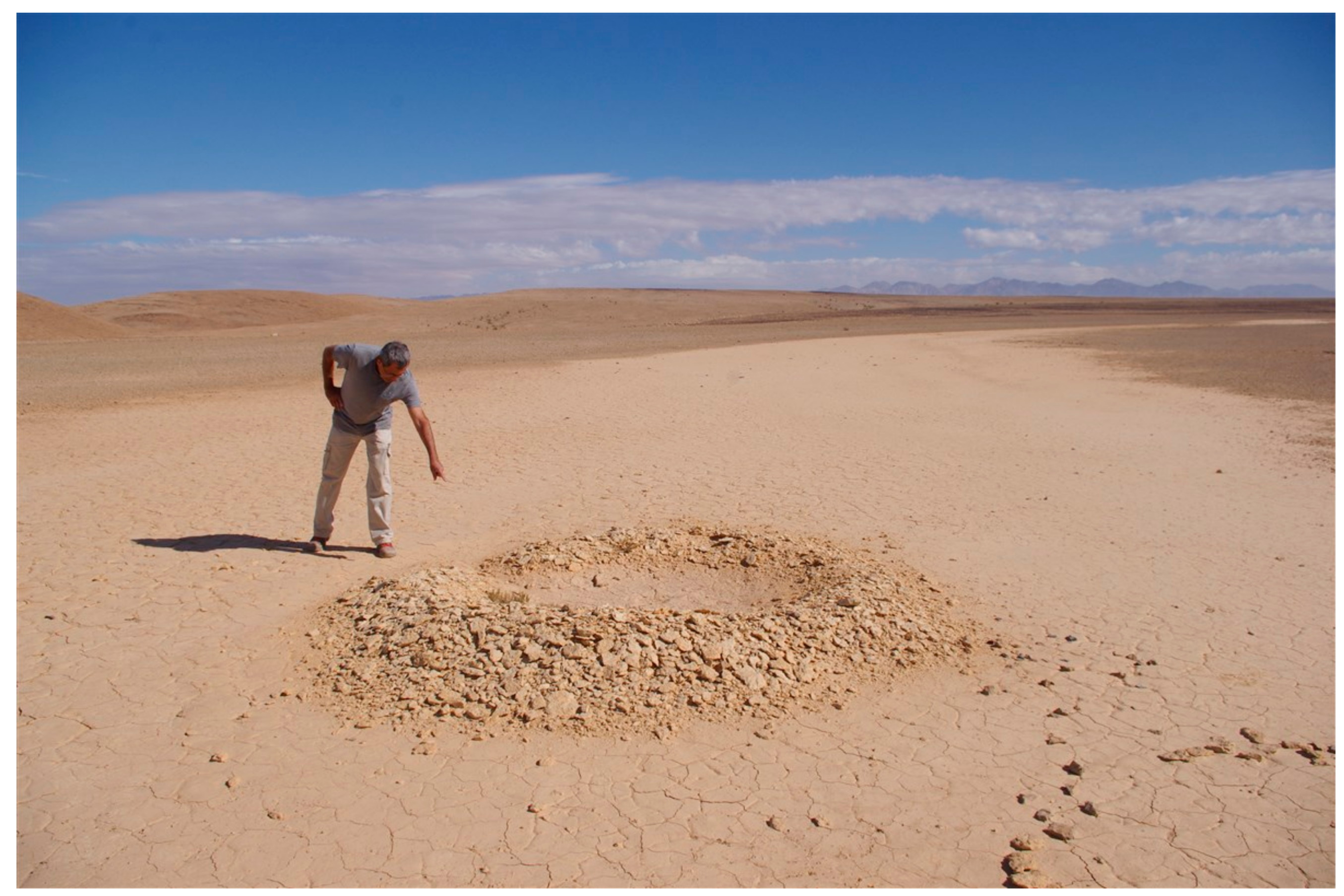
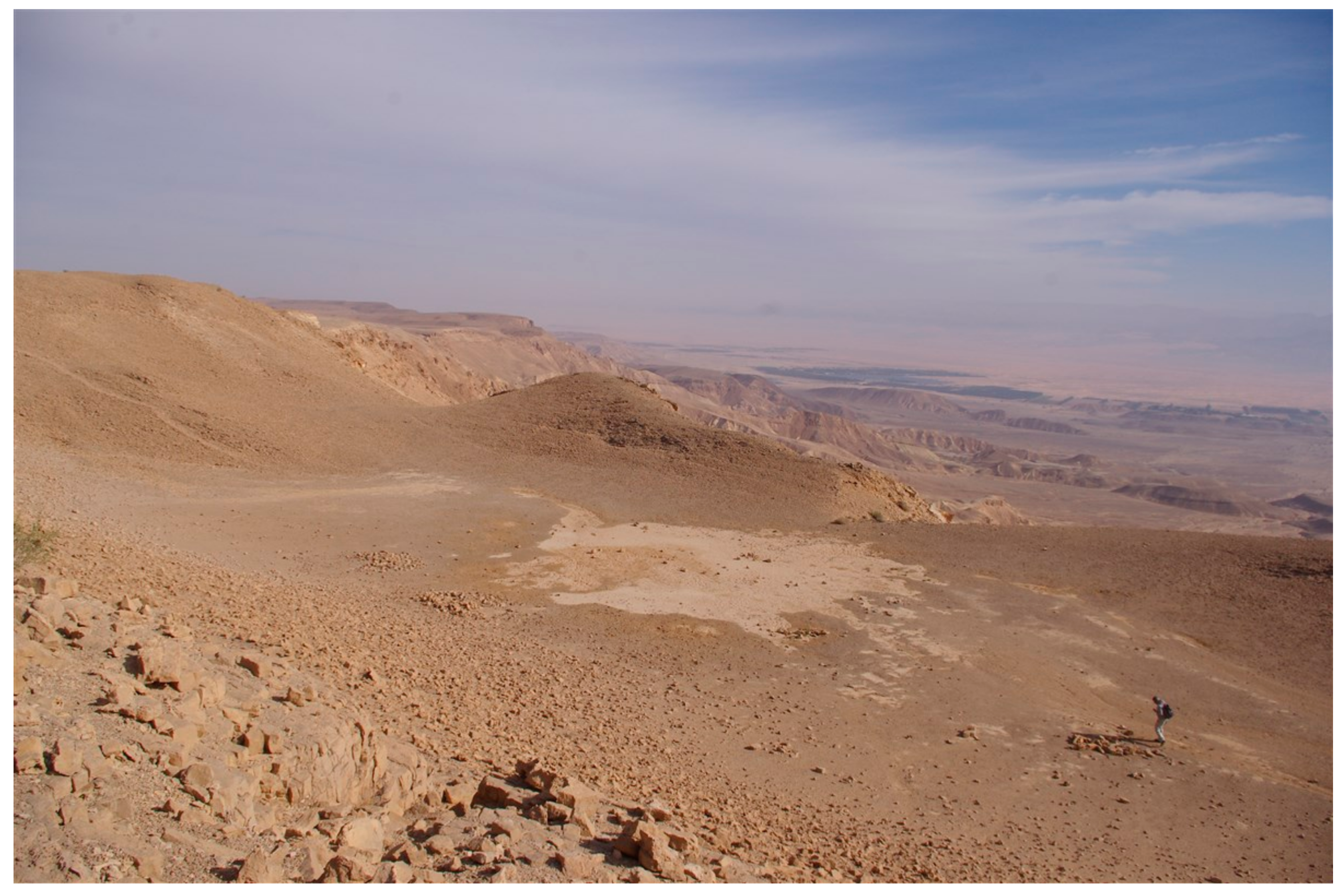
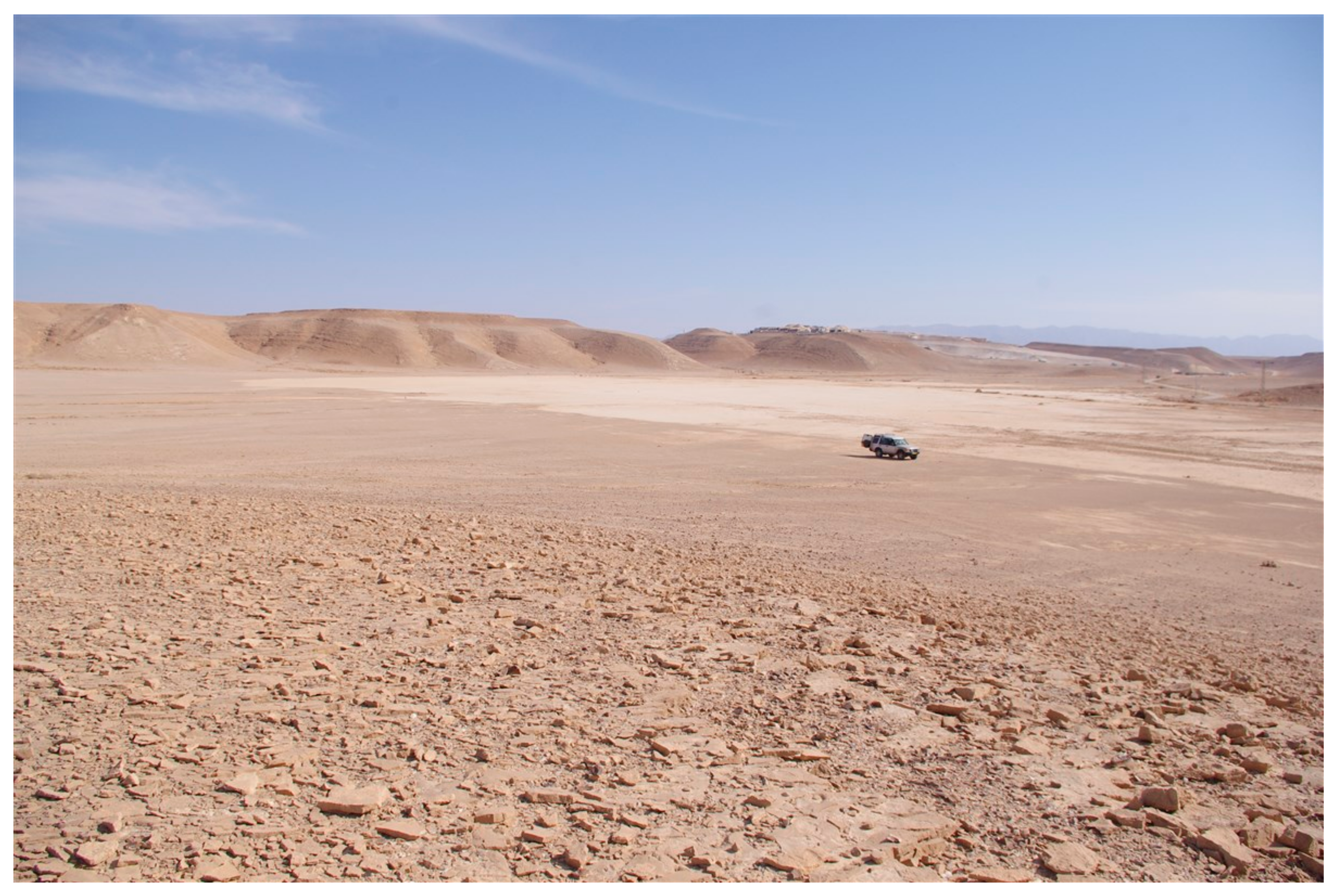

| Recharge Playa | El-Sa’edin | Shizafon | Shaharut | Girzi | Avraham | Se’ipim | Re’u’el |
|---|---|---|---|---|---|---|---|
| Central longitude (°) | 30.108157 | 30.113178 | 29.923251 | 29.969472 | 29.964323 | 29.689264 | 29.925556 |
| Central latitude (°) | 35.179081 | 35.008214 | 34.994974 | 34.859447 | 34.859769 | 34.884939 | 35.008278 |
| Mean altitude (m a.s.l.) | 194 | 340 | 469 | 580 | 580 | 792 | 525 |
| Depression bed area (km2) | 8.7 | 0.188 | 0.133 | 0.037 | 0.056 | 0.007 | 0.00042 |
| Drainage basin area (km2) | 285 | 2.23 | 3.662 | 0.374 | 0.927 | 0.112 | 0.0263 |
| Adjacent hillslopes area (km2) | 27.7 | 1.03 | 0.59 | 0.374 | 0.927 | 0.08 | 0.01 |
| Neot Smadar * | Yotvata ** | |||||||||||||||
|---|---|---|---|---|---|---|---|---|---|---|---|---|---|---|---|---|
| Year/Month | October | November | December | January | February | March | April | Total | October | November | December | January | February | March | April | Total |
| 2000–2001 | 0 | 0 | 0 | 0 | 0 | 0 | 0 | 0 | 0 | 0 | 13.2 | 0 | 0 | 0 | 0 | 13.2 |
| 2001–2002 | 0 | 0 | 7 | 0 | 0 | 0 | 8.8 | 15.8 | 0 | 0 | 0 | 0 | 0 | 0 | 0 | 0 |
| 2002–2003 | 0 | 0 | 0 | 0 | 0 | 0 | 0 | 0 | 0 | 0 | 0 | 0 | 0 | 0 | 0 | 0 |
| 2003–2004 | 0 | 0 | 0 | 0 | 11.2 | 0 | 0 | 11.2 | 0 | 0 | 18.2 | 0 | 10.3 | 0 | 0 | 28.5 |
| 2004–2005 | 0 | 0 | 0 | 0 | 0 | 6.3 | 0 | 6.3 | 0 | 0 | 0 | 0 | 0 | 0 | 0 | 0 |
| 2005–2006 | 0 | 0 | 0 | 0 | 0 | 0 | 0 | 0 | 0 | 0 | 0 | 0 | 0 | 0 | 0 | 0 |
| 2006–2007 | 0 | 0 | 0 | 0 | 0 | 0 | 0 | 0 | 0 | 0 | 0 | 0 | 0 | 0 | 0 | 0 |
| 2007–2008 | 0 | 0 | 0 | 0 | 0 | 0 | 0 | 0 | 0 | 0 | 0 | 0 | 0 | 0 | 0 | 0 |
| 2008–2009 | 0 | 0 | 0 | 0 | 0 | 0 | 0 | 0 | 0 | 0 | 0 | 0 | 0 | 0 | 0 | 0 |
| 2009–2010 | 0 | 0 | 0 | 19.5 | 9.4 | 0 | 0 | 28.5 | 0 | 0 | 0 | 22.3 | 17.6 | 0 | 0 | 39.9 |
| 2010–2011 | 0 | 0 | 0 | 0 | 0 | 0 | 0 | 0 | 0 | 0 | 8.1 | 0 | 0 | 0 | 0 | 8.1 |
| 2011–2012 | 0 | 0 | 0 | 0 | 0 | 0 | 0 | 0 | 0 | 0 | 0 | 0 | 0 | 0 | 0 | 0 |
| 2012–2013 | 20.0 | 0 | 0 | 0 | 0 | 0 | 0 | 20 | 0 | 0 | 0 | 0 | 0 | 0 | 0 | 0 |
| 2013–2014 | 0 | 0 | 0 | 0 | 0 | 0 | 0 | 0 | 0 | 0 | 0 | 0 | 10.7 | 0 | 0 | 10.7 |
| 2014–2015 | 0 | 0 | 7.8 | 6.7 | 0 | 0 | 0 | 13.7 | NA | NA | NA | NA | NA | NA | NA | NA |
| 2015–2016 | 19.7 | 0 | 6.5 | 0 | 0 | 21.5 | 6.6 | 53.6 | NA | NA | NA | NA | NA | NA | NA | NA |
| 2016–2017 | 11.3 | 0 | 10.4 | 0 | 0 | 0 | 28.7 | 49.4 | NA | NA | NA | NA | NA | NA | NA | NA |
| Mean | 2.9 | 0.0 | 1.8 | 1.5 | 1.3 | 1.6 | 2.6 | 11.7 | 0.0 | 0.0 | 2.8 | 1.6 | 2.8 | 0.0 | 0.0 | 7.2 |
| # years with 10–20 mm rainstorms | 3 | 0 | 1 | 1 | 1 | 0 | 0 | 6 | 0 | 0 | 2 | 0 | 3 | 0 | 0 | 5 |
| # years with 20–30 mm rainstorms | 0 | 0 | 0 | 0 | 0 | 1 | 1 | 2 | 0 | 0 | 0 | 1 | 0 | 0 | 0 | 1 |
| # years with >30 mm rainstorms | 0 | 0 | 0 | 0 | 0 | 0 | 0 | 0 | 0 | 0 | 0 | 0 | 0 | 0 | 0 | 0 |
| Rain Over Source Area (mm) | 10 | 20 | 30 | 10 | 20 | 30 | |
|---|---|---|---|---|---|---|---|
| Playa | Source: Sink Ratio | Cr = 0.15 | Cr = 0.30 | ||||
| El-Sa’edin | 31.8 | 48 | 95 | 143 | 95 | 191 | 286 |
| Shizafon | 10.9 | 16 | 33 | 49 | 33 | 66 | 98 |
| Shaharut | 26.7 | 40 | 80 | 120 | 80 | 160 | 240 |
| Girzi | 9.1 | 14 | 27 | 41 | 27 | 55 | 82 |
| Avraham | 15.6 | 23 | 47 | 70 | 47 | 93 | 140 |
| Se’ipim | 15 | 23 | 45 | 68 | 45 | 90 | 135 |
| Re’u’el | 61.6 | 92 | 185 | 277 | 185 | 370 | 555 |
| Rain Over Source Area (mm) | 10 | 20 | 30 | 10 | 20 | 30 | |
|---|---|---|---|---|---|---|---|
| Playa | Source:Sink Ratio | Cr = 0.25 | Cr = 0.55 | ||||
| El-Sa’edin | 3.2 | 8 | 16 | 24 | 18 | 35 | 53 |
| Shizafon | 5.5 | 14 | 28 | 41 | 30 | 61 | 91 |
| Shaharut | 4.4 | 11 | 22 | 33 | 24 | 49 | 73 |
| Girzi | 10.1 | 25 | 51 | 76 | 56 | 111 | 167 |
| Avraham | 16.6 | 41 | 83 | 124 | 91 | 182 | 273 |
| Se’ipim | 11.5 | 29 | 58 | 86 | 63 | 127 | 190 |
| Re’u’el | 28.1 | 70 | 140 | 211 | 155 | 309 | 464 |
| Rain Over Source Area | 10 | 20 | 30 |
|---|---|---|---|
| Playa | |||
| El-Sa’edin | 5 –103 | 102–206 | 152–310 |
| Shizafon | 22–47 | 44–93 | 66–140 |
| Shaharut | 44–91 | 89–182 | 133–273 |
| Girzi | 40–56 | 81–111 | 121–167 |
| Avraham | 66–91 | 132–182 | 199–273 |
| Se’ipim | 34–74 | 68–148 | 102–221 |
| Re’u’el | 121–255 | 241–510 | 362–765 |
| RUNON Depth (mm) | Crop | Sowing Date | Growing Season Length (Days) | Crop Evapotranspiration (ETc: mm) | Water Deficit (D: mm) |
|---|---|---|---|---|---|
| 300 | Barley | 1 November | 120 | 229–273 | (−)78.2–(−)34.2 |
| 150 | 311–352 | (+)3.8–(+)44.8 | |||
| Wheat | 120 | 229–289 | (−)78.2–(−)18.2 | ||
| 150 | 311–376 | (+)3.8–(+)68.8 | |||
| Barley | 1 January | 120 | 347–385 | (+)39.8–(+)77.8 | |
| 150 | 484–540 | (+)176.8–(+)232.8 | |||
| Wheat | 120 | 347–402 | (+)39.8–(+)94.8 | ||
| 150 | 484–564 | (+)176.8–(+)256.8 | |||
| Barley | 1 February | 120 | 468–517 | (+)160.8–(+)209.8 | |
| 150 | 628–696 | (+)320.8–(+)388.8 | |||
| Wheat | 120 | 468–538 | (+)160.8–(+)230.8 | ||
| 150 | 628–725 | (+)320.8–(+)417.8 | |||
| 400 | Barley | 1 November | 120 | 229–273 | (−)178.2–(−)134.2 |
| 150 | 311–352 | (−)96.2–(−)55.2 | |||
| Wheat | 120 | 229–289 | (−)178.2–(−)118.2 | ||
| 150 | 311–376 | (−)96.2–(−)31.2 | |||
| Barley | 1 January | 120 | 347–385 | (−)60.2–(−)22.2 | |
| 150 | 484–540 | (+)76.8–(+)132.8 | |||
| Wheat | 120 | 347–402 | (−)60.2–(−)5.2 | ||
| 150 | 484–564 | (+)76.8–(+)156.8 | |||
| Barley | 1 February | 120 | 468–517 | (+)60.8–(+)109.8 | |
| 150 | 628–696 | (+)220.8–(+)288.8 | |||
| Wheat | 120 | 468–538 | (+)60.8–(+)130.8 | ||
| 150 | 628–725 | (+)220.8–(+)317.8 |
© 2017 by the authors. Licensee MDPI, Basel, Switzerland. This article is an open access article distributed under the terms and conditions of the Creative Commons Attribution (CC BY) license (http://creativecommons.org/licenses/by/4.0/).
Share and Cite
Stavi, I.; Shem-Tov, R.; Ragolsky, G.; Lekach, J. Ancient to Recent-Past Runoff Harvesting Agriculture in Recharge Playas of the Hyper-Arid Southern Israel. Water 2017, 9, 991. https://doi.org/10.3390/w9120991
Stavi I, Shem-Tov R, Ragolsky G, Lekach J. Ancient to Recent-Past Runoff Harvesting Agriculture in Recharge Playas of the Hyper-Arid Southern Israel. Water. 2017; 9(12):991. https://doi.org/10.3390/w9120991
Chicago/Turabian StyleStavi, Ilan, Rahamim Shem-Tov, Gidon Ragolsky, and Judith Lekach. 2017. "Ancient to Recent-Past Runoff Harvesting Agriculture in Recharge Playas of the Hyper-Arid Southern Israel" Water 9, no. 12: 991. https://doi.org/10.3390/w9120991
APA StyleStavi, I., Shem-Tov, R., Ragolsky, G., & Lekach, J. (2017). Ancient to Recent-Past Runoff Harvesting Agriculture in Recharge Playas of the Hyper-Arid Southern Israel. Water, 9(12), 991. https://doi.org/10.3390/w9120991







